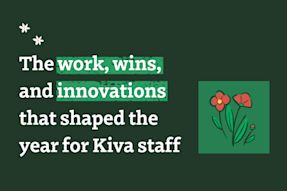Donate to Kiva today and help us invest in groups like Cacao de Aroma.
Life as a Cocalero
Like thousands of children in the northern jungle of Peru, Jarver Gonzales and Jorge Luis Trujillo both grew up seeing their fathers cultivate coca leaves, the plant used to make cocaine.
To many, coca was their respite from poverty. In the 1980’s and 1990’s, it was the only economic opportunity in the remote region of Tocache in Alto Huallaga, where unpaved dirt roads are interwoven between lush green trees, access to a good education was scarce and many are driven by the desire to live a calm and stable life.
Despite its profitability, farming coca was far from calm.
Most farmers, known as “cocaleros,” ended up living under the control of drug traffickers. The rebel group Shining Path was the most threatening, killing many and immersing the farmers in a life full of violence.
With support from the Shining Path, drug traffickers controlled most of the 115,000 acres of coca crops that were in Peru by 1995.
What was promised to be as an escape from poverty and an opportunity to put food on the table resulted in a life of fear. Many farmers were also arrested, including Jorge Luis’s dad.
 Jorge Luis in his cacao farm in Tocache, San Martin, Peru.
Jorge Luis in his cacao farm in Tocache, San Martin, Peru.“Due to an incident, [my dad] was arrested for being involved with coca,” says Jorge Luis. “So he decided to change crops and dedicate himself to cacao.”
Like Jorge’s father, thousands of farmers took the same route and to escape the control of the drug traffickers.
By the early 2000’s, various foreign organizations like the UN started offering farmers an economic incentive to switch from coca to cacao with the goal to eradicate the production of coca in the region.
According to the UN, by 2005, coca production was reduced by 72%.
As one challenge ended, another began.
 Left: Cacao bean freshly picked from the cacao pod. Right: Toasted cacao bean.
Left: Cacao bean freshly picked from the cacao pod. Right: Toasted cacao bean.“When they eradicated it, the issue was that there wasn’t economic support and people didn’t know what to cultivate, because previously there wasn’t the commercialization of cacao or coffee and the price was really low,” says Jarver.
Yet many farmers took the same risk, organized themselves and started various co-ops to harvest and sell the cacao bean, giving many children like Jarver and Jorge the opportunity to have a new life.
“The persistence that [my dad] had allowed him to provide an education to his four sons with the production of cacao,” says Jorge. “Since then, we’re devoting ourselves to the cacao.”
At the expense of his dad’s previous experience in the coca fields, Jorge was able to get a higher education with the new earnings in cacao and become a business partner with his father in a cooperative called CPCACAO.
Incentives for farming cacao started to end the cycle of illegal coca farming, but economic growth was still stagnant due to the lack of cacao commercialization. They were far from exporting to other countries.
 Cacao de Aroma’s manager Higor Jaramillo outside their offices in Tocache, San Martin.
Cacao de Aroma’s manager Higor Jaramillo outside their offices in Tocache, San Martin. Cacao de Aroma
In 2014, Cooperativa Agrária Central de Cacao de Aroma (Cacao de Aroma) was formed to break that barrier and prove that there was no need to return to the illegal cultivation of coca.
The organization serves as a channel of commercialization for 6 cooperatives to help them export, receive financing and serve as a platform that helps solve common needs of its members.
But starting off wasn’t easy.
The minimum amount of cacao needed to ship internationally is 25 tons. At the time, they lacked sufficient cash flow to buy that volume of product from their farmers, like Jarver.
While money wasn’t flowing in like he desired, going back to the life he saw his father live wasn’t an option for Jarver. He had faith in his cooperatives CPCACAO and Cacao de Aroma and stayed determined.
In 2017, Kiva stepped in.
 Cacao beans being put inside a their exporting bag.
Cacao beans being put inside a their exporting bag.How our lenders are reinventing the wheel
1,210 Kiva lenders gave more than 800 rural cacao-farming families a new opportunity through our Direct to Social Enterprise program, better known as DSE.
With a loan of $40,000, powered by our lenders at a 0% interest rate, Cacao de Aroma started on its journey of growth with one of their first loans ever, thanks to Kiva.
“With the leverage from Kiva we were able to [buy more cacao], gather that volume and export. All this helped us be able to create a credit history and therefore access bigger credit lines. It was an extraordinary leverage where you can now see the results,” says Cacao de Aroma’s manager, Higor Jaramillo.
As a result, farmers started getting paid a fair wage and more than 800 farming families began creating new opportunities for their children, leaving the days of cultivating coca behind.
A new era was beginning.
 Team of Cacao de Aroma outside their offices in Tocache, San Martin, Peru.
Team of Cacao de Aroma outside their offices in Tocache, San Martin, Peru.In 2 short years, since the first loan from Kiva, Cacao de Aroma boomed. The farmers’ desire to succeed in this new life away from violence and fear drove them to success.
“With this support, which for us is important, we can achieve great things. Imagine, we started off at 80 tons [of cacao] for commercialization and now we’re at 1,000 tons since Kiva gave us the loan. It was fundamental,” says Higor.
 Cacao field in Tocache, San Martin, Peru.
Cacao field in Tocache, San Martin, Peru. In 2019, Kiva lenders continued fueling this growth by funding a second loan and helped Cacao de Aroma buy cacao from more farmers, reaching more than 900 farming families. The cooperative increased their exporting efforts and therefore increased farmers’ wages by 30%.
“The loan with Kiva was like the impulse that generated this avalanche that came right after,” says Higor.
It’s an impact that is not only demonstrated in the numbers, but also in the quality of life of those who grew up experiencing one of the worst eras in the region’s history.
To those whose childhoods consisted of witnessing their fathers get arrested and people get killed, working with cacao and receiving a loan from Kiva allowed them to break the cycle and have an opportunity to succeed in a life that many didn’t think was possible. Kiva lenders are helping them break the generational cycle.
 Jorge next to barrels filled with cacao beans that are going through the fermentation process.
Jorge next to barrels filled with cacao beans that are going through the fermentation process.“Cacao for us means we can succeed and have a better quality of life in peace. Thanks to that, we were able to go to school, get a career, a profession and now, I can do the same for my children, motivating them to study, to be professionals and to be good people in this society,” Jorge says. “Kiva is helping many families producers of cacao better their life conditions and we are very grateful for the opportunity.”
Jorge and Jarver both say they’ve turned a new page and that with Kiva’s support, they are sure they will continue to grow.
We want to continue supporting people like Jorge and Jarver. But we need your help! Since 100% of the money you lend on Kiva goes to the field, Kiva relies on optional tips and donations from individuals like you to cover our costs. Donate here!
PREVIOUS ARTICLE
Employee Spotlight: Kofi Friar →NEXT ARTICLE
Q-and-A with a lender: Mrs. Prester and her entrepreneurship class! →














